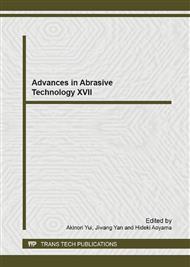p.447
p.452
p.458
p.467
p.473
p.479
p.485
p.489
p.495
Synergistic and Strengthening Mechanism of Twin Boundaries under Nanoindentations for Cadmium Telluride Semiconductors
Abstract:
In this study, eight nanotwinned cadmium telluride (CdTe or CZ) models were employed to investigate the synergistic and strengthening mechanism of twin boundaries under nanoindentations, using molecular dynamics (MD) simulations. Twin thickness between adjacent boundaries of 16 nm exhibited the maximum hardness during unloading conditions, among eight MD models with twin thickness varied from 4 to 23 nm. The maximum hardness was formed by the synergistic and strengthening effect induced by the stress fields between upper and lower twin boundaries under nanoindentations. When the twin thickness was less than 16 nm, the hardness increased with increasing twin thickness. Whereas, when the twin thickness was more than 16 nm, the hardness decreased with increasing twin thickness.
Info:
Periodical:
Pages:
473-478
Citation:
Online since:
September 2014
Authors:
Keywords:
Price:
Сopyright:
© 2014 Trans Tech Publications Ltd. All Rights Reserved
Share:
Citation:


